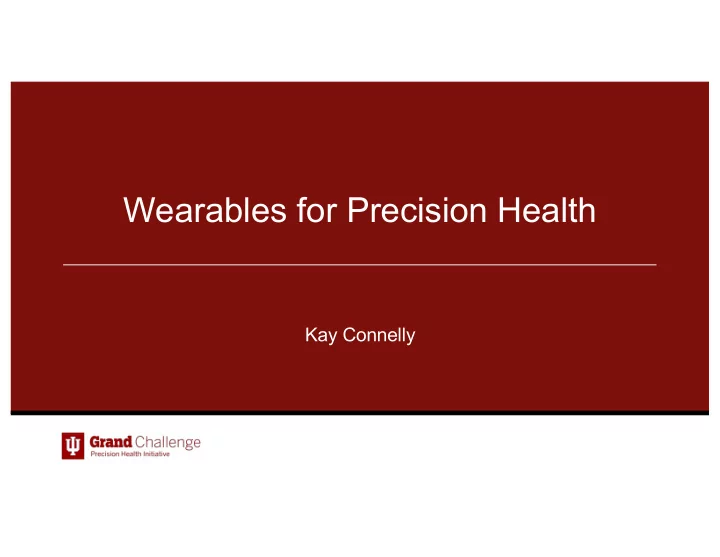

Wearables for Precision Health Kay Connelly
IU Grand Challenge Precision Health Initiative The goal of the IU Precision Health Initiative is to position Indiana University among the leading universities in discovering and developing better treatments, preventions and improved health outcomes in specific human diseases through a more precise understanding of the genetic, developmental, behavioral and environmental factors that contribute to an individual’s health.
IU Precision Diabetes Program PI’s: Drs. David Haas and Kay Connelly
Gestational Diabetes (GDM) 14% of pregnancies 60-70% develop T2D in 5-10 years
Phase I Overview • Leaders : David Haas & Kay Connelly • Hypothesis : Genetic, blood-based, and behavioral/digital biomarkers can be identified that distinguish gradations of risk for future Type 2 diabetes beyond usual clinical measures Population NuMoM2b Cohort Hoosier Moms Cohort Directed refinement of Analysis Biomarker Discovery discovery Tools Provide novel discoveries regarding GDM-related diabetes Target risk that inform preventive care strategies regarding Outcomes pathways to diabetes in this unique subset of diabetes
Phase II Overview • Leaders : Tami Hannon & Jen Wessel • Hypothesis : Genetic and other molecular information, together with psychological and sociodemographic features of the individual, can inform the delivery of prevention intervention and enhance the effectiveness and patient-centered value of these interventions
Behavioral Data: Wearable… But Which One? Analog Viewability Battery Synching Activity & Sleep
Behavioral Data: Wearable… But Which One? Evaluation Framework Usability Study Pilot Study 1 2 3 4 5 6 Wearables Birth Mothers Pregnant Narrowing Selections Final Selection Testing & Understanding Use
Evaluation Framework Physiological measures Motivation Notifications Clock Functionality Manual inputs/reminders Connectivity to other apps Privacy Ease of setup Ease of physical controls Wearable display viewability Infrastructure Wearable display interpretability Device/data access Mobile app ease of use Cost Everyday Wearability API: data Use Water Resistance API: scalability Wearable device battery API: notification Mobile battery API: maturity Syncing Open source/API reference Aesthetics Developer support Customization
Narrowing Selections • Identified 10 devices at proper cost point (<$150) • Prioritized features for women of young children (e.g. active lifestyle => battery life, water proof, etc…) • Narrowed to 3 devices:
Usability Study tasks preferences Garmin Vivosmart HR
Pilot Study Final Focus Groups Pause Focus Groups Interviews Month 1 Month 2 Month 3 Month 4 Month 5 Month 6 Wearables Recover from Birth New Mothers Pregnant Mothers Pre-Birth • 38 participants, 8 weeks before & after birth • Wearable feedback: Did they like the form? Features? App? • Wearable usage: Did they wear it? Charge it? Synch regularly? • Did the feedback or usage change pre/post birth?
Pilot Study: Major Findings Form Factor “The only issue thus far has been that it is a bit bulky/unnatural feeling to wear. I am not in the habit of wearing bracelets, watches, etc., so I have found it particularly noticeable. I have been removing it at night for comfort, so have not been able to take advantage of sleep monitoring.” [A007]
Pilot Study: Major Findings Post Pregnancy Use • Drop in usage post-pregnancy • Participants noted being “too busy” and/or “too tired” to be exercising • Viewed device to be an exercise tracker rather than a lifestyle tracker
Behavioral Data: Wearable 1 2 3 4 5 6 Wearables Birth Mothers Pregnant
Phase I Overview • Leaders : David Haas & Kay Connelly • Hypothesis : Genetic, blood-based, and behavioral/digital biomarkers can be identified that distinguish gradations of risk for future Type 2 diabetes beyond usual clinical measures Population NuMoM2b Cohort Hoosier Moms Cohort Directed refinement of Analysis Biomarker Discovery discovery Tools Provide novel discoveries regarding GDM-related diabetes Target risk that inform preventive care strategies regarding Outcomes pathways to diabetes in this unique subset of diabetes
GDM Models • NuMoM2B • EHR+survey models being produced now • Genomic data added in fall • Hoosier Mom’s Cohort • 500 women recruited in their first trimester è Current recruitment at n=50 • Data: • EHRs, surveys, genomics • + food diaries, wearables • Model with behavioral data >1 year out
Questions? Collaborators: Katie Siek, Cassie Kresnye, Haley Molchan, Rashmi Bidanta, Novia Nurain Kay Connelly connelly@indiana.edu
Recommend
More recommend